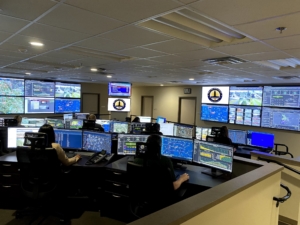Public safety is front and center with public officials today. Big changes are coming as historic amounts of federal funding pour into cities, counties, states and special purpose districts for projects to improve public safety that will be launched in 2023. One common thread is that among the diverse range of safety projects already planned, the vast majority depend on an abundance of new technologies.
Funding is available for all types of safety-related projects. The Federal Emergency Management Agency (FEMA) has funding available annually to modernize and improve firefighting services. The agency’s Assistance to Firefighters Grant program provides support to fire departments, emergency medical service organizations and state fire training academies. Almost all projects will call for the implementation of various types of new technologies. Last year’s funding allocation of $359 million is still being allocated and the agency is poised to disburse another $324 million. Awardees are allowed a 24-month performance period for acquiring and implementing technology improvements.
Another federal grant program created through the Infrastructure Investment and Jobs Act (IIJA) supports local deployment of public safety technology along heavily trafficked and dangerous roadways. This month, the USDOT allocated $800 million in funding for road safety projects through the Safe Streets and Roads for All program. Congress appropriated a total of $5 billion in funding to encourage the use of technology designed to improve roadway safety.
One such grant of $22.9 million will allow local transportation officials in Austin, Texas, to launch safety improvement initiatives. City leaders have identified several life-saving initiatives and technology purchases are expected to include traffic signalization, enhanced lighting for crosswalks and well-defined turning lanes with technology to enhance pedestrian safety.
A $23 million project in Alameda County will improve safety along a corridor that is a high-collision corridor. A partnership involving the cities of Berkeley and Albany, along with Alameda County Transit and the California Department of Transportation has been formed to oversee numerous safety enhancements. A safety project along San Pablo Avenue will include numerous technology components designed to reduce collisions, mitigate traffic congestion and allow safer crossings for pedestrians and cyclists. Bus bulb-outs at transit stops, lighting upgrades and enhanced traffic signalization technology will also be a part of the project.
Funding for public safety initiatives is also more abundant than in the past. City, county and state leaders are allocating significant portions of their upcoming budgets to technology purchases to enhance public safety. In Baltimore, Md., a $46 million capital project will usher in a technology-focused approach to public safety. Planning documents indicate that current safety-related technology will be upgraded and modernized. New communication systems and other tech components designed to promote adaptive public safety support for residents will be incorporated as well.
The mayor of Springfield, Ill., announced recently that numerous public safety projects will be included in the city’s future budget. The proposed spending plan will direct officials to use federal funding for multiple types of public safety technology acquisitions. Digital speed limit signage will be deployed to collect data and a traffic preemption system will be expanded across the entire city. The system will allow emergency vehicles to interface with traffic signals so alerts can control intersections during emergencies. The signal technology will allow officials to stop traffic from both directions during an incident to minimize the risk of other collisions and challenges to emergency responsiveness.
The focus on public safety has also resulted in multijurisdictional partnerships which are consolidating efforts to deploy new technology on a wider, regionalized scale. These collaborative efforts will be focused on technology that allows officials to streamline services and improve the responsiveness of public safety efforts. An example of this type of collaboration is taking shape in Texas. In the southern region of the state, Pharr city leaders have partnered with nearby South Texas College to develop a regional public safety training center that will house high-tech equipment such as driving simulators, virtual reality shooting ranges and street-smart simulators.
Public safety technology will be used in the state of New York to develop regional crime prevention centers. The state’s Crime Analysis Center Network includes a series of 10 regional police intelligence hubs and the governor recently announced that the network of crime centers will be expanded to include a new one focused on the New York City area. To support that effort, the state has allocated $36 million for the project. Development of the city-facing crime analysis center will be overseen by the state’s Department of Criminal Justice Services. Innovative technology that gathers and analyzes data will be required as well as technology that coordinates the sharing of data and intelligence among more than 350 law enforcement agencies.
School districts are also launching various types of new safety projects, all of which include new technology. The Richland School District in Washington is seeking voter approval for the acquisition of safety and security technology. District administrators have identified potential acquisitions which include monitors for school entryways, surveillance systems and upgraded access controls for all district facilities.
Companies with technology to support public safety initiatives will have hundreds of upcoming opportunities to monitor in 2023. And, the anticipated projects will be spread across various locations, and with diverse objectives.







